Getting Started
BIOL 353 (SP 2018) Getting Started
BIOL 353 - Getting Started
You will have 3 lab write-ups for Comparative Animal Physiology that require you to find peer-reviewed journal articles on your topic.
This guide will assist you in:
- Developing search strategies to obtain your peer-reviewed journal articles
- Locating CSUSM Biology databases
- Searching Google Scholar
- Providing resources on citation styles
Use the tabs to the left to navigate through this guide.
Lit. Definitions
BIOL 353 Literature Terminology
Literature Terminology
For your reports, you will need to incorporate a number of different types of sources. Make sure you understand the difference!
Watch this tutorial to learn about the peer-review process.
Examples of different types of literature:
- Literature Review - (peer-reviewed, secondary)
- Empirical Study - (peer-reviewed, primary)
|
Terminology review |
|
Journal |
|
Electronic journal |
|
Peer-review |
|
Peer-reviewed journal article |
|
Primary literature |
|
Literature review When it is part of a research article, the literature review will also discuss how the research that is to be discussed helps to provide further knowledge on the subject. |
Search Tips
Search Tips BIOL 353 FA 17
Search Tips
Don't spend hours sifting through article results that don't seem relevant.
Limit all the junk!
- Come up with multiple keywords/synonyms about your topic
- Search for a specific genus/species rather than a broader term.
- Use "quotes" for exact phrases
- Use AND/OR/NOT to connect your keywords.
-
- AND - connects main concepts of your search (Less results)
- OR - connect synonyms of the same concept (More results)
- NOT - Eliminates concepts that are not relevant
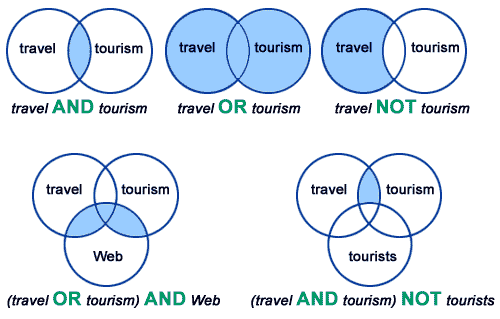
Image source: https://ircutp.wordpress.com/utp-irc-faqs/boolean-operators/
Databases
Databases can be very particular and each one is different. CSUSM has over 150 different databases with different subjects and materials. For BIOL 353, the recommended databases are listed below.
To access the full text, look for PDF or Get It! at CSUSM
If an article is not available via full text, click the "Request this Item" button in the CSUSM Library catalog. The Library will order the article for you. It will take approx. 2-4 days to receive the article electronically. If not button appears, go to the main ILL page and input the information for your source manually.
NOTE: All databases can be used off-campus with your student id/password. Start at the CSUSM Library website to access the database or you will not have Get It! at CSUSM links.
If you need any additional assistance, please contact Talitha Matlin.
Most Useful
| Database | Full Text | Coverage | Scholarly |
|---|---|---|---|
| PubMed @ CSUSM i
The premier database of world biomedical literature on clinical medicine and preclinical research. Medline provides a more user-friendly interface, but less updated content. |
Some full-text; plus links to full-text via Get-It | 1966 to current | All |
| Web of Science i
Contains citation indexes for Science, Social Sciences, Arts & Humanities, and Book Citations from 2004 to present. Select "Web of Science Core Collection" to conduct cited reference search. |
Links to full-text via Get-It | 1975 to current | All |
| Biological Abstracts i
A complete collection of bibliographic references covering life science and biomedical research literature published from more than 4,000 journals internationally. |
Some full-text; plus links to full-text via Get-It | 1969 to current | Most |
| Google Scholar CSUSM i
Link to citations and full-text from your CSUSM Library databases and beyond! |
Some full-text; plus links to full-text via Get-It | current to current | All |
Also Useful
Google Scholar
BIOL 353 Google Scholar
Make sure to access Google Scholar through the CSUSM Library website (see Databases tab) in order to link the Get It! At CSUSM button to access full text articles.
Searching and Keywords
Start by going to the Databases tab and click on Google Scholar.
Once on the main page, we recommend using the Advanced Search, which can be found on the upper left hand corner in the menu.



On the Advanced Search menu, you can enter keywords about your topic. With Google Scholar, we recommend being as specific as possible or you will return too many results. Be as specific as possible when describing your topic. Try to include the specific genus/species rather than general terms (ie: sturgeon fish versus organism).
To narrow down the search results, put main keywords and click the “in the title of the article” button in the Advanced Google Scholar menu. Main concepts of an article will likely appear in the title of the article.
You can also reduce the number of articles by selecting a specific date range if you are needing articles from a certain time period or articles that are more current.
Results Page
On the search results page, you will be able to see the title of the article, author names, journal information, and the abstract. The abstract is very important for selecting useful articles. The abstract provides a summary of the article. Make sure to read the abstract before reading the full article.
Once you find an article that looks promising, you will need to locate the Get It! At CSUSM button. The button is sometimes located in the right margin next to the article. More frequently, the button likes to hide. Click the arrows underneath the article information and it will show the Get It! At CSUSM button.
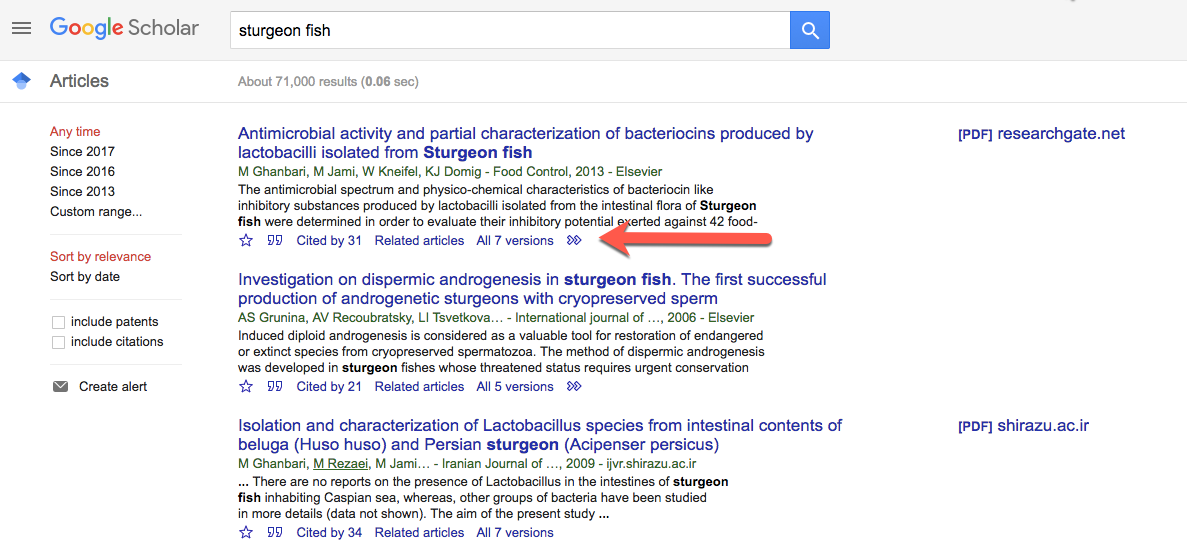
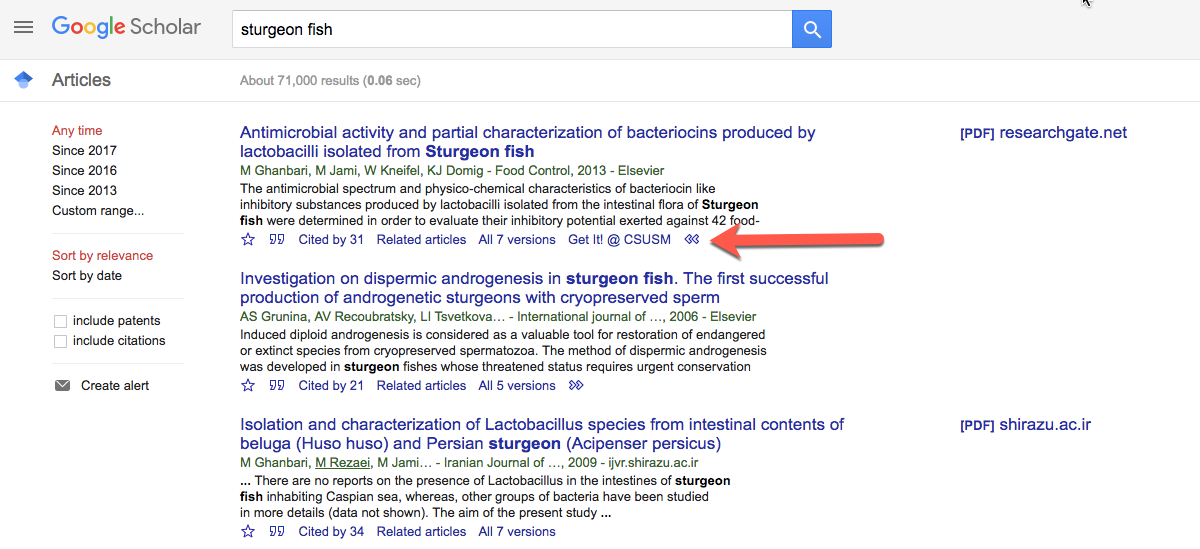
How to Get the Full Text of the Article
Once you click on the Get It! At CSUSM button, you will be taken to the CSUSM Library catalog page for the article.
If the article is available full text, click on the full text link:
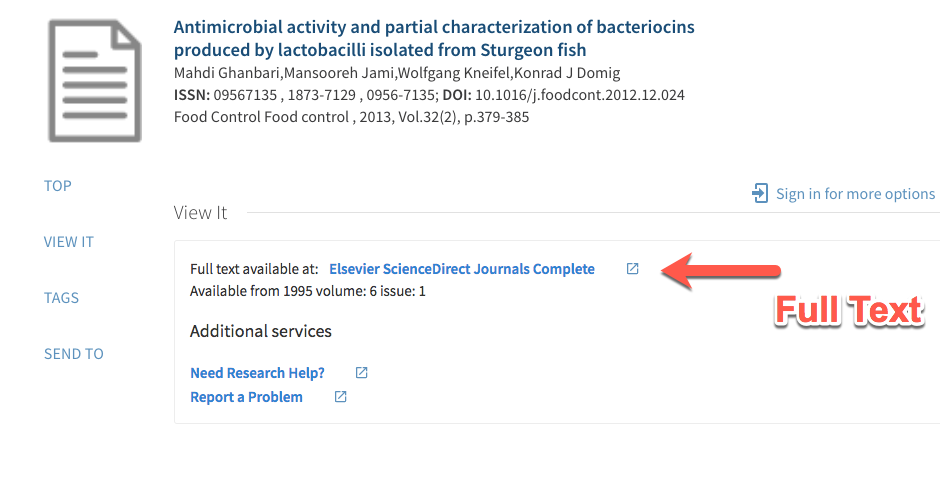
If the article does not have full text available, you can order the article via full text by clicking on the “Request this Item” button.

Citations
BIOL 353 Citations Journal of Experimental Biology (SP17)
Citations - Journal of Experimental Biology
See the JEB's Manuscript Preparation page for citation examples and tips.
Paraphrasing
Follow the steps outlined by the Purdue Online Writing Lab to learn how to paraphrase correctly.
Direct Quotations
Follow the steps outlined by the Purdue Online Writing Lab to learn when to use direct quotations.
In-text citations - used in the body of the paper
- Single author paraphrase, one article: (Lienemann, 1938)
- Single author paraphrase, two or more articles: (Lienemann, 1938; Jamison, 2006).
- Two authors paraphrase, one article: (Morritt and Spicer, 1996)
- Two authors paraphrase, two or more articles: (Morritt and Spicer, 1996; Jamison, 2006; Smith, 1997).
- More than two authors paraphrase, one article: (Morritt et al., 1998)
- More than two authors paraphrase, two or more articles: (Morritt et al., 1998; Lienemann, 1938; Gupta et al., 2004).
References List
- List references in alphabetical order.
- Use bold for authors' names and volume number.
- Abbreviate journal names according to ISO Abbreviation.
- If there are more than 10 authors, use 'et al.' after the 10th author.
SINGLE AUTHOR:
Author last name, First Initial. Second Initial. (Year). Title with all words in lowercase except proper nouns and Genus Sp. in italics. Abbreviated Journal Title Volume, page-pages.
Bradley, T. J. (1984). Mitochondrial placement and function in insect ion-transporting cells. Am. Zool. 24, 157-167.
TWO AUTHORS:
Waugh, J. M. and Aarssen, L. W. (2012). Size distributions and dispersions along a 485-year chronosequence for sand dune vegetation. Ecol. Evol. 2, 719-726.
THREE TO TEN AUTHORS (yes, you list them all in bibliography)
Paig-Tran, E. W., Bizzarro, J. J., Strother, J. A., and Summers, A. P. (2011). Bottles as models predicting the effects of varying swimming speed and morphology on size and selectivity and filtering efficiency in fishes. J. Exp. Biol. 214, 1643-1654.
ELEVEN OR MORE AUTHORS (after the 10th author, use 'et al.')
Rovio, A. T., Abel J., Ahola, A. L., Andres, A. M., Bertranpetit, J., Blancher, A., Bontrop, R. E., Chemnick, L. G., Cooke, H. J., Cummins, J. M., et al. (2004). A prevalent POLG CAG microsatellite length allele in humans and African great apes. Mamm. Genome 15, 492-502.
USING WORK BY SAME AUTHOR, SAME YEAR:
Smith, A. B. (1995a). Epithelial cell structure and polarity. Eur. J. Cell Biol. 53, 25-54.
Smith, A. B. (1995b). The rise in blood glucose during hibernation of the golden headed plover Dickus birdus. J. Avian Med. Surg. 20, 19-21.
TIPS ON LOCATING THE CORRECT JOURNAL TITLE ABBREVIATION
- You can find these abbreviations by searching the NLM Journal Catalog. You can search for a journal by topic, title, or ISSN. In the journal's record, search for the ISO abbreviation -- notice sometimes periods are used in the abbreviation, sometimes not.

Last Update: January 22, 2014 13:31
For other Citation Styles, see: CSUSM Citations Guide
Sitewide guides menu
Talitha Matlin
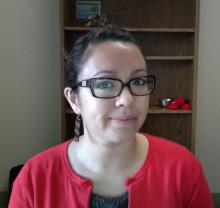
760-750-4342
KEL 3423
